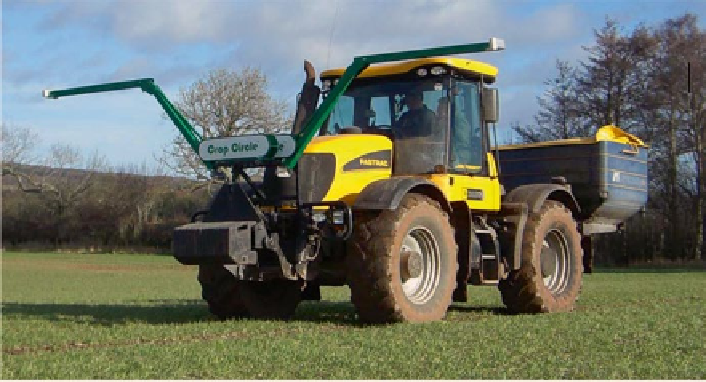Agriculture Reference
In-Depth Information
Fig. 9.24
Control of nitrogen spreading via reflectance sensing based on artificial light with verti-
cal viewing of the canopy from transverse booms in front of the tractor (Crop Circle concept, photo
from Wilson J., SoilEssentials Ltd., England)
used light sources include xenon lamps, laser diodes and light emitting diodes
(LEDs). As with natural light, the view on the canopy can be in a vertical or in an
oblique direction.
For an oblique direction sidewards down from the tractor-roof, there is no need
anymore to take care of the effect of any solar azimuth angle. So, contrary to the
concept dealt with above in Figs.
9.22
and
9.23
, it suffices to use a single sensor on
each side of the tractor.
Since shade effects on the signals that result from the machinery too are excluded
with artificial illumination, the transverse booms needed for vertical viewing can be
shorter (Fig.
9.24
) than with natural light. Yet the most compact design still in pos-
sible with oblique viewing from the tractor roof (Fig.
9.25
).
However, the mounting itself of the sensors probably is less important with artifi-
cial illumination. Crucial is that the sensors see what is needed for the control of the
spreader. And this depends on the viewing direction too. With an oblique viewing
direction, the sensor sees less soil than with a vertically oriented view. This is because
the slanted view hides small bare patches by plants. In this respect, the oblique view
is advantageous with early development stages and with widely spaced crops.
But because an oblique orientation sees more
biomass
than a vertical view, its
reflectance indices also tend to saturate faster. The term “
saturation
” here is used
for the relation between the respective reflectance index and the leaf- area-index of
the crop. A saturated reflectance index cannot differentiate between leaf-area-
indices at high levels. But the ability to indicate high levels of leaf-area-indices with
precision is very important for nitrogen sensing. Because an increasing nitrogen
supply affects the leaf-area-index of a crop even more than the chlorophyll concen-
tration within its leaves (Fig.
9.17
).

